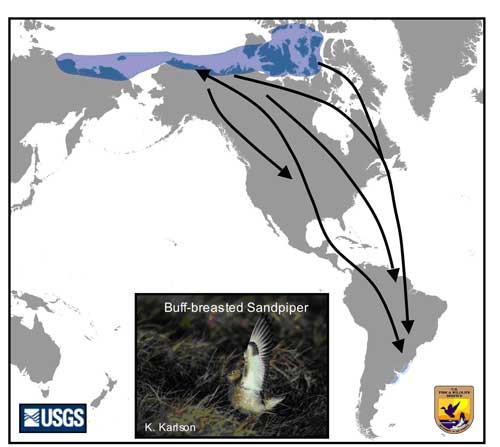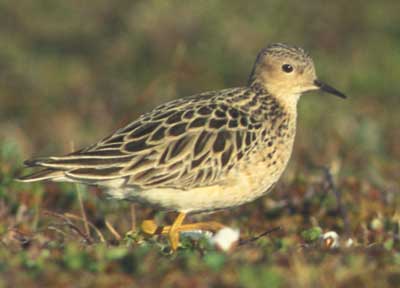Buff-breasted Sandpiper, Tryngites subruficollis
High-Priority Species ListBreeding
There are few known high concentration sites for this species in the Arctic. In addition, abundance fluctuates dramatically from year-to-year at any one site (Lanctot and Laredo 1994). However, Buff-breasted Sandpipers were found in reliable and fairly good numbers near the Sagavanirktok River near Deadhorse (Lanctot and Weatherhead 1997). Study plots located close by had breeding densities that ranged from 0 to 10 birds/km2 during 1971-1974 (Bergman et al. 1977) and between 0.5-14.0 from 1981 to 1989 (average =- 5.7; Troy and Wickliffe 1990). Moderate densities of birds have also been reported at the Ikpikpuk and Canning rivers (Garner and Reynolds 1986, R. Lanctot, unpubl).
Spring and fall migration
There are no known post-breeding concentration sites for this species in the Arctic. However, the species is known to aggregate at specific sites in Nebraska, Kansas, and Texas during both spring and fall migration.
Sampling locations: Breeding birds will primarily be sampled on the North Slope at established camps at Prudhoe Bay. Smaller numbers will be sampled at other locations such as Barrow, Teshekpuk Lake, and the Canning River. Secondary, spring and fall migrants will be sampled in the Central United States, including the Rainwater Basin in Nebraska, and the Cheyenne Bottoms and Quivira NWRs in Kansas.
Sampling timeframe: Breeding birds will be sampled during June and early July; spring migrants will be sampled during April and May, and fall migrants will be sampled in August through September.
Sample demographics: Adults will be sampled during spring migration and breeding, and adults and juveniles will be sampled during fall migration. Methods of capture: Birds breeding on the North Slope will be live-trapped on nests using walk-in and bow traps, and with mist nets at lek locations. Spring and fall migrants in the Central United States will be live-trapped using walk-in traps, mist nets, and/or rocket nets. Fecal sampling will occur at lek locations where adult males establish territories, and at migration sites where birds stage are observed feeding.
Ability to capture birds: Breeding locations: As part of an intensive Buff-breasted Sandpiper study at Prudhoe Bay, 224 adults were captured in 1992-1994 (Lanctot and Weatherhead 1997). We anticipate that we could capture about 70 adults at this one site in 2006, and gather another 50-100 fecal samples. Biologists at other breeding sites are likely to be able to capture another 30 birds and fecal sample 40-80 more. Spring and fall migration: No effort has been made to capture migratory Buff-breasted Sandpipers in the past. The goal of the ecotoxicology study is to sample 80 birds at the migration sites (B. Sandercock, unpubl.).
Other targeted species: At the proposed primary breeding sites it will be possible to sample small to moderate numbers of Dunlin, Long-billed Dowitchers, and Pectoral Sandpipers.
Contact: Richard Lanctot
Yukon Delta NWR
Brown, S., C. Hickey, B. Harrington, and R. Gill, eds. 2001. The U.S. Shorebird Conservation Plan, 2nd ed. Manomet Center for Conservation Sciences, Manomet, MA.
Garner, G.W. and P.E. Reynolds. 1986. Final report baseline study of the fish, wildlife, and their habitats. U.S. Dept of Interior, U.S. Fish and Wildlife Service, Anchorage, Alaska
Johnson, J.A., R.B. Lanctot, B.A. Andres, J.R. Bart, S.C. Brown, S.J. Kendall, and D.C. Payer. In review. Distribution of breeding shorebirds on the Arctic Coastal Plain of Alaska. Arctic.
Lanctot, R.B. and C.D. Laredo. 1994. Buff-breasted Sandpiper (Tryngites subruficollis). In The Birds of North America, No. 91 (A. Poole and F. Gill, eds.). Philadelphia: The Academy of Natural Sciences; Washington, D.C.: The American Ornithologists’ Union.
Lanctot, R.B. and P.J. Weatherhead. 1997. Ephemeral lekking behavior in the Buff-breasted Sandpiper, Tryngites subruficollis. Behavioral Ecology 8:268-278.
Troy, D.M. and J.K. Wickliffe. 1990. Trends in bird use of the Pt. McIntyre Reference Area 1981-1989.Unpubl. report by Troy Ecological Research Associates for BP Exploration (Alaska) Inc.
U.S. Interagency Strategic Plan. 2006. Final Draft: An early detection system for Asian H5N1 highly pathogenic avian influenza in wild migratory birds.

Ranking Score: 10.0
Asian H5N1 ranking criteria for Buff-breasted Sandpiper, Tryngites subruficollis.
Total of partial contact with Asia1 |
Contact with known "hot spot"2 |
Habitat used in Asia3 |
Pop. in Alaska4 |
Can samples be obtained? |
Score |
2.0 |
1.0 |
3.0 |
2.0 |
2.0 |
10.0 |
Small portion of population nests Wrangel Is & Chukotka then returns to nonbreeding area in southern S. America |
No known use of AI-infected areas |
Variable but generally dry upland tundra |
~3,000 including ~1,000 from Chukotka/Wrangel Is, stopping on southward migration |
Could be difficult to obtain target number |

